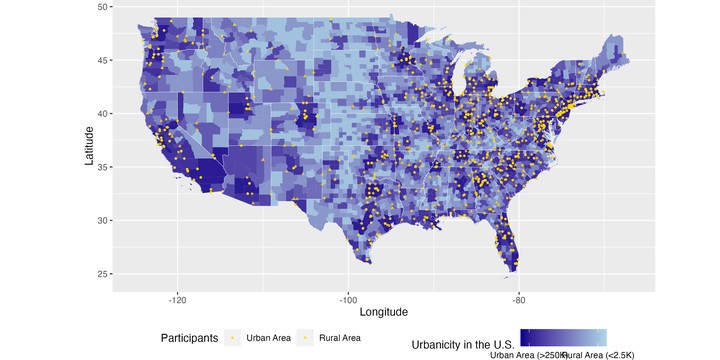Digital Interventions for Rural Adolescents
 Made by Yama Chang, 2022
Made by Yama Chang, 2022Objective
Rural teens are less likely to access care for depression than urban teens. Evidence-based digital single-session interventions (SSIs), offered via social media advertisements, may be well-suited to narrowing this gap in treatment access and increasing rural adolescents’ access to support. We evaluated the viability of using social media-based advertisements to equitably recruit rural adolescents with elevated depression symptoms online SSIs; we sought to characterize and assess whether SSI completion rates and acceptability differed for rural versus more urban adolescents, across three intervention conditions (two active, evidence-based SSIs; one placebo control); and we tested whether digital SSIs differentially reduced depressive symptoms.
Method
We used pre-intervention and three-month follow up data from 13- to 16-year-old adolescents (N = 2,322; 88% female; 55% non-Hispanic White) within a web-based randomized control trial of three free, online SSIs (ClinicalTrials.gov identifier: blinded for review) collected eight months into the COVID-19 pandemic in the United States.
Results
Digital SSIs reached rural and urban adolescents at population-congruent rates; however, social media ads resulted in relative underrepresentation of rural youths who holding minoritized racial/ethnic identities. Rural adolescents also completed digital SSIs at similar rates to their urban peers, found SSIs equivalently as acceptable, and reported comparable depression symptom reductions as urban youth.
Conclusion
Digital SSIs and their dissemination through social media may offer a promising means of narrowing the gap between rural and urban adolescents’ access to evidence-based mental health support; however, targeted efforts are warranted to reach racially minoritized youths in rural U.S. counties.
Citation
Szkody, E., Chang, Y. W., & Schleider, J. L. (2023). Serving the Underserved? Uptake, Effectiveness, and Acceptability of Digital SSIs for Rural American Adolescents. Journal of Clinical Child & Adolescent Psychology, 1-14.
Read more
This paper has been published on the Journal of Clinical Child and Adolescent Psychology. If you need the access to the full paper, please don't hesitate to email me, and I'd be happy to provide you with the published PDF file. You can also find the pre-registration and open code on OSF.